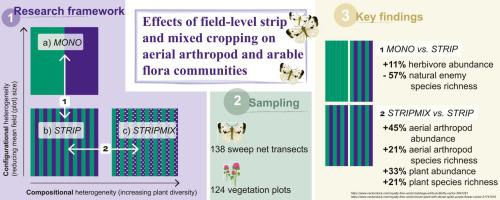Agriculture, Ecosystems & Environment ( IF 6.0 ) Pub Date : 2023-05-11 , DOI: 10.1016/j.agee.2023.108568 Fogelina Cuperus , Wim A. Ozinga , Felix J.J.A. Bianchi , Luuk Croijmans , Walter A.H. Rossing , Dirk F. van Apeldoorn

|
Loss of arthropod biodiversity can impair the provision of ecosystem services in agricultural landscapes. Crop diversification strategies offer the possibility to support arthropod communities without putting aside agricultural land as conservation areas. Within-field crop diversification measures, such as strip cropping and crop mixtures, may provide arthropods with continuity and diversity in food, shelter and habitat at fine spatial and temporal resolutions. However, it is unclear how strip cropping and plant species diversity within strips influences aerial arthropod and weed communities in commercially sized arable fields. In this 2-year study we tested the effects of crop heterogeneity on aerial arthropod and plant communities in organically managed strip fields. We tested effects of configurational crop heterogeneity by comparing sole cropping (MONO) with strip cropping (STRIP), and compositional crop heterogeneity by comparing STRIP with flower-legume-grain crop mixtures grown in strips (STRIPMIX). Aerial arthropod communities were assessed in 138 sweep net transects and plant communities in 124 vegetation plots in cabbage, wheat, sugar beet and barley. Higher configurational crop heterogeneity by strip cropping reduced herbivore abundances and increased natural enemy species richness in organic cabbage strips. Cabbage in MONO had a significantly higher herbivore abundance (+11%) and a lower natural enemy species richness (−57%) than cabbage in STRIP. Higher compositional crop heterogeneity by sowing additional plant species in strips (STRIPMIX) significantly increased plant abundance (+33%), plant species richness (+21%), total aerial arthropod abundance (+45%), and total aerial arthropod species richness (+21%) compared to STRIP. Our work shows that both configuration of crop areas (MONO vs. STRIP) and plant species diversity within strips (STRIP vs. STRIPMIX) can support arthropod biodiversity and natural pest suppression, but that arthropod responses differ between diversification strategies and crop combinations. Further optimization of design and management of within-field crop diversification strategies holds potential to attain biodiversity-based cropping systems which deliver multiple ecosystem services and have a reduced dependency on pesticides.
中文翻译:

田间带状和混作对气生节肢动物和可耕植物群落的影响
节肢动物生物多样性的丧失会损害农业景观中生态系统服务的提供。作物多样化战略提供了支持节肢动物群落的可能性,而无需将农业用地划为保护区。田间作物多样化措施,如条带种植和混合作物,可以在精细的空间和时间分辨率下为节肢动物提供食物、住所和栖息地的连续性和多样性。然而,目前尚不清楚带状作物和带状植物物种多样性如何影响商业规模耕地中的空中节肢动物和杂草群落。在这项为期 2 年的研究中,我们测试了作物异质性对有机管理的带状田地中的空中节肢动物和植物群落的影响。MONO ) 带状种植 ( STRIP ),以及通过比较STRIP与花卉-豆科植物-谷物混合作物 ( STRIPMIX )的作物组成异质性。在卷心菜、小麦、甜菜和大麦的 124 个植被地块的 138 个扫网样带和植物群落中评估了空中节肢动物群落。带状种植带来的更高配置的作物异质性减少了草食动物的丰度,增加了有机卷心菜条带中的天敌物种丰富度。与STRIP中的卷心菜相比, MONO中的卷心菜具有显着更高的食草动物丰度 (+11%) 和较低的天敌物种丰富度 (-57%). 通过在条带中播种额外的植物物种 ( STRIPMIX )提高作物的组成异质性,显着增加了植物丰度 (+33%)、植物物种丰富度 (+21%)、总空中节肢动物丰度 (+45%) 和总空中节肢动物物种丰富度 ( +21%) 与 STRIP 相比。我们的工作表明,作物区域的配置(MONO与STRIP)和带内植物物种多样性(STRIP与STRIPMIX) 可以支持节肢动物生物多样性和自然害虫抑制,但节肢动物的反应在多样化策略和作物组合之间有所不同。进一步优化田间作物多样化战略的设计和管理有可能实现基于生物多样性的种植系统,提供多种生态系统服务并减少对杀虫剂的依赖。











































 京公网安备 11010802027423号
京公网安备 11010802027423号